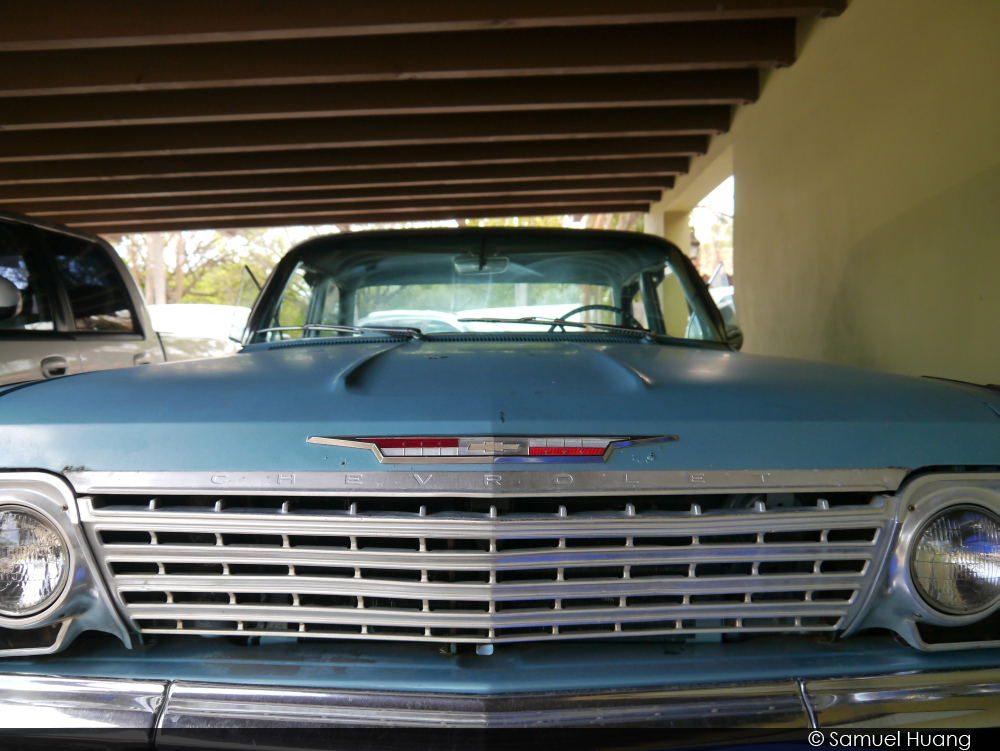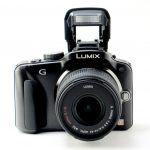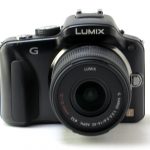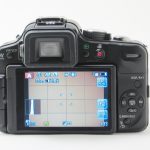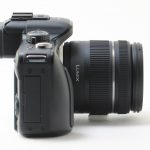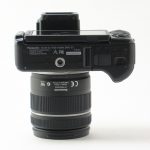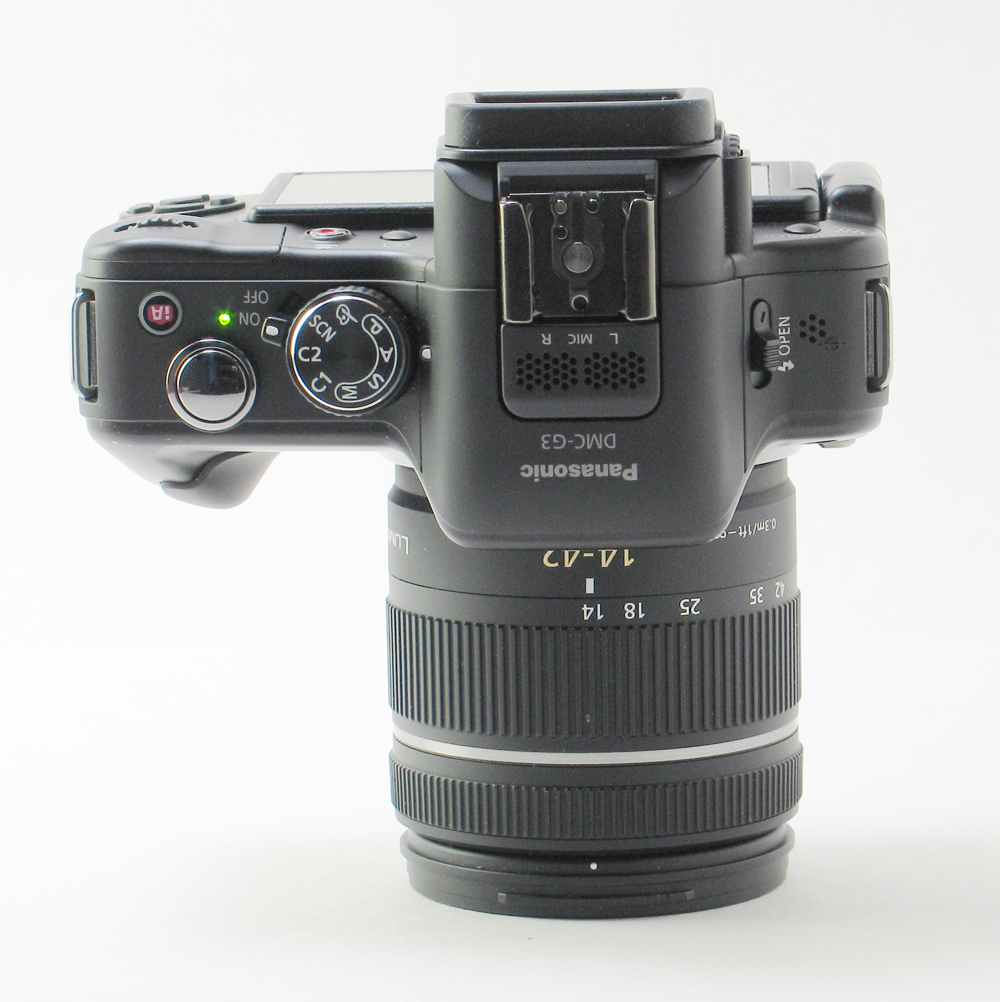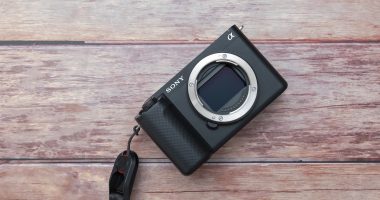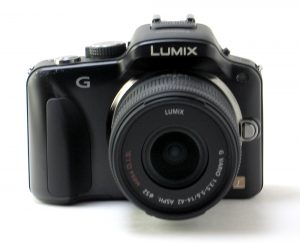 The Panasonic Lumix DMC-G3 is the third generation of their excellent G-series lineup. It differs from their GF and GX series in that the DMC-G3 is more DSLR-like which is evident by it’s slightly larger grip and protruding electronic viewfinder. I’ll start off by saying that this is the first mirrorless system camera that I’ve used with an electronic viewfinder. I’ve used optical view finders on regular DSLRs before but not the electronic ones. This however is not my first time reviewing a Micro Four Thirds camera as I reviewed the excellent Olympus PEN E-PL3 earlier this year which uses the same lens system as the G3. The lenses however do differ in that these are Panasonic Lumix made lenses that feature Leica designs.
The Panasonic Lumix DMC-G3 is the third generation of their excellent G-series lineup. It differs from their GF and GX series in that the DMC-G3 is more DSLR-like which is evident by it’s slightly larger grip and protruding electronic viewfinder. I’ll start off by saying that this is the first mirrorless system camera that I’ve used with an electronic viewfinder. I’ve used optical view finders on regular DSLRs before but not the electronic ones. This however is not my first time reviewing a Micro Four Thirds camera as I reviewed the excellent Olympus PEN E-PL3 earlier this year which uses the same lens system as the G3. The lenses however do differ in that these are Panasonic Lumix made lenses that feature Leica designs.
If you haven’t done so already, I suggest you check out my initial first impressions of the Panasonic Lumix DMC-G3 that I posted up a few days ago here. It contains lots of information about the overall body of the G3 as well as built quality and features. This review here will deal mainly with the actual usage of the camera, the image quality, and my overall impression of the camera as a whole. What we will not talk about here are detailed specs and numbers as I don’t really do that. That is mostly information that interests serious professionals and that’s not my goal with this review. My goal is to inform the average person whether or not this is a good camera and how fun it is to shoot with.
Design of the Body & Features
 I’ll just go over this section quickly as most of it is included in my initial first impression post here. First of all, I really like the feel of this camera. It fits very comfortably in your hands, thanks in part to the larger hand grip and rubber coated finger grips. The camera is a bit heavier than the other cameras I’ve used but the weight gives it a nice solid, sturdy feel. Because the DMC-G3 is so comfortable to hold, I was able to shoot a lot with it using just 1 hand, but mainly when I was using the electronic viewfinder (EVF).
I’ll just go over this section quickly as most of it is included in my initial first impression post here. First of all, I really like the feel of this camera. It fits very comfortably in your hands, thanks in part to the larger hand grip and rubber coated finger grips. The camera is a bit heavier than the other cameras I’ve used but the weight gives it a nice solid, sturdy feel. Because the DMC-G3 is so comfortable to hold, I was able to shoot a lot with it using just 1 hand, but mainly when I was using the electronic viewfinder (EVF).
The 14-42mm kit lens decent unit, but there were a few gripes I had with it. First, the lens itself is quite large, especially when compared to the unit that Olympus includes with their PEN kit. It gets even larger if you add the included lens hood to it (which I did not have). This makes the idea of pocketing the DMC-G3 out of the question. I was also a bit annoyed by the lack of smoothness the zoom ring had when rotating it. It always felt like there was too mcuh resistance to it which made it very difficult to rotate the ring smoothly. Despite these 2 issues, I was able to take some very good photos using this lens, which in the end, take good photos is that matters.
Like I’ve stated before, I do so love cameras with articulating screens. These allow you to take photos at difficult angles sometimes and it also allows you to take a photos a bit more discretely sometimes. The DMC-G3’s articulating screen is like that found on most DSLRs. It is hinged to the side of the camera and folds outwards. It is in the outward position that allows it to tilt and rotate for different angles but you can fold it back onto the body with the LCD side facing towards you. This has some advantages and disadvantages. The advantages are that this type of design offers more versatility than the type I’ve seen on the Sony NEX-5N and the Olympus PEN E-PL3. You can shoot the camera in almost any position and still be able to see the screen. The disadvantage however is that this design still feels a bit fragile to me due to its design so you’ll need to be careful when handling it.
Operations (Usage)
 With the G3, I decided to use this camera a bit differently from the other mirrorless cameras I was using before. With those other cameras, I mainly used the view screen to compose all my shots and would shoot mainly from chest level or even waist level. With the G3, because it included an EVF (electronic viewfinder) I decided to shoot mostly only using the EVF. The only time I would ever use the view screen would be to adjust setting in the menu or view images in playback mode. This meant that I was using the G3 more like a standard DSLR and less like a point and shoot. This suited the camera just fine however as it is more similar to a DSLR and the smaller size of the G3 and weight compared to a DSLR meant that I was easily shooting one-handed. The only time I would use 2 hands is if I had to really stabilize the camera or to adjust the lens.
With the G3, I decided to use this camera a bit differently from the other mirrorless cameras I was using before. With those other cameras, I mainly used the view screen to compose all my shots and would shoot mainly from chest level or even waist level. With the G3, because it included an EVF (electronic viewfinder) I decided to shoot mostly only using the EVF. The only time I would ever use the view screen would be to adjust setting in the menu or view images in playback mode. This meant that I was using the G3 more like a standard DSLR and less like a point and shoot. This suited the camera just fine however as it is more similar to a DSLR and the smaller size of the G3 and weight compared to a DSLR meant that I was easily shooting one-handed. The only time I would use 2 hands is if I had to really stabilize the camera or to adjust the lens.
Like I said in the initial impression post, I really liked the how comfortable this camera felt and how easily it was to reach most of the buttons without having to reposition my hand. All I had to do was move my thumb around.
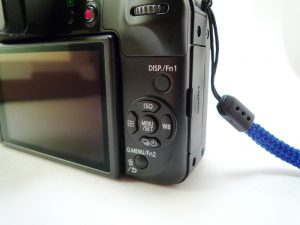 I’d like to talk about the software now on this Lumix DMC-G3. If you’ve used other Lumix cameras before, the software and menu system should be pretty familiar to you. I have an old DMC-FX500 touchscreen point and shoot from many years ago and the software and menu doesn’t seem that much different from the DMC-G3. In fact, because I had used that camera before, it was quite simple to jump right into the G3 and make adjustments where I needed. My favorite feature of the Lumix software is the Q Menu aka Quick Menu. The Q Menu allows you to change readily used settings quickly and easily without having to stumble through the more detailed menus and tabs to get to what you need. All you have to do is press the Q Menu button with your thumb and then use the directional buttons or tap on the screen to the feature you need adjusting and change it. You can do all this without having to leave the framing area and you can still see your subject while doing it. The Q Menu also allows you to change multiple settings very quickly, more so that some of the other cameras I’ve used lately.
I’d like to talk about the software now on this Lumix DMC-G3. If you’ve used other Lumix cameras before, the software and menu system should be pretty familiar to you. I have an old DMC-FX500 touchscreen point and shoot from many years ago and the software and menu doesn’t seem that much different from the DMC-G3. In fact, because I had used that camera before, it was quite simple to jump right into the G3 and make adjustments where I needed. My favorite feature of the Lumix software is the Q Menu aka Quick Menu. The Q Menu allows you to change readily used settings quickly and easily without having to stumble through the more detailed menus and tabs to get to what you need. All you have to do is press the Q Menu button with your thumb and then use the directional buttons or tap on the screen to the feature you need adjusting and change it. You can do all this without having to leave the framing area and you can still see your subject while doing it. The Q Menu also allows you to change multiple settings very quickly, more so that some of the other cameras I’ve used lately.
While shooting, I noticed that the G3 is very fast when it comes to focusing, especially in daylight. I had no problems focusing on what I wanted to focus on and it did I really quickly. Not quite as fast as a DSLR, but I don’t think most users would even notice a difference. The only time the G3 had trouble focusing was during low-light situations, but like most digital cameras I’ve used, this is a problem most of them all share. Luckily, the G3 has an excellent manual focusing solution in which you can set the camera to pop up a little screen within the screen that shows you a magnified area of your focusing point. This lets you manually focus precisely without having to leave the framing screen. This means you can still see the entire area of your photo while focusing on 1 specific area. It’s something I wish more cameras would adopt.
Photo Quality
Here is where the Panasonic Lumix DMC-G3 really shines. This camera takes some really excellent photos. Part of that has to do with the fact that the G3 utilizes a 16 megapixel sensor as opposed to a 12 megapixel sensor like most other Micro Four Thirds cameras. Even with the kit lens, the G3 produced some really detailed shots. (These are all color shots with zero post editing. All are shot wide open in aperture priority mode).
Chevy.
Vinyl Lager.
Party food.
Happy Birthday.
Rainbow netting.
No idea what these are.
I’ll say it again, in the end, it doesn’t really matter how many features a camera has. What really matters the most is the overall image quality and whether or not you think it produces the kind of images you want it to produce. In this case, I would say the Lumix DMC-G3 did exactly what I wanted it to do and I am more than happy with the overall outcome of all my photos.
Available Accessories
Since the DMC-G3 is a Micro Four Thirds camera, you will be pleased to know that there is an abundance of available lenses for the G3 from both Panasonic and Olympus. Of all the mirrorless cameras out there, the Micro Four Thirds system has by far the must number of available lenses for you to choose from. With that said, you’ll be able to find the perfect lens for yourself based on your needs.
Now in terms of accessories, there isn’t much available, but then again, you don’t really need any. The G3 already has a built in electronic viewfinder so it’s not something you need to add to the camera. What’s also great about having the built in EVF is that it frees up the hot shoe so that you can use it for more powerful external flashes.
Final Thoughts
 If you are looking for a very good Micro Four Thirds camera that is not really that expensive, has a 16 megapixel sensor, and a built in electronic viewfinder, the Panasonic Lumix DMC-G3 is definitely the camera for you. It’s fast, comfortable to hold, and has tons of included features that you would normally have to pay extra for with other cameras. The main features of the G3 that sets is apart from its siblings is that it has that built in electronic viewfinder and the flip-out tilting touch screen. At $699, it’s a little bit more than the DMC-GX1 or the DMC-GF3, but the added features make up for the price difference and then some.
If you are looking for a very good Micro Four Thirds camera that is not really that expensive, has a 16 megapixel sensor, and a built in electronic viewfinder, the Panasonic Lumix DMC-G3 is definitely the camera for you. It’s fast, comfortable to hold, and has tons of included features that you would normally have to pay extra for with other cameras. The main features of the G3 that sets is apart from its siblings is that it has that built in electronic viewfinder and the flip-out tilting touch screen. At $699, it’s a little bit more than the DMC-GX1 or the DMC-GF3, but the added features make up for the price difference and then some.
If you’re looking for a pocketable M4/3 camera though, look somewhere else as even if you were to use Panasonic’s excellent 14mm f/2.5 prime lens, which is tiny, you still wouldn’t be able to fit this camera in any sort of pocket due to the protruding viewfinder. The G3 is however smaller than your typical DSLR and lighter as well so if you were looking for a DSLR style form factor, the G3 is every bit as comfortable as one but smaller and lighter.
It was a real joy playing with the DMC-G3 as I stated in the review, the autofocus on this camera was lighting fast and it was so easy to handle. I was able to do a lot of one-handed shooting when needed and the EVF seemed to make a world of difference when framing each photo. The G3 allows you to shoot with both the EVF and the view screen allowing to to change your shooting style when need be. I really appreciate the fact that the G3 has both choices available to you and in fact made me wish that my personal cameras has such functionality without me having to purchase any extra accessory.
